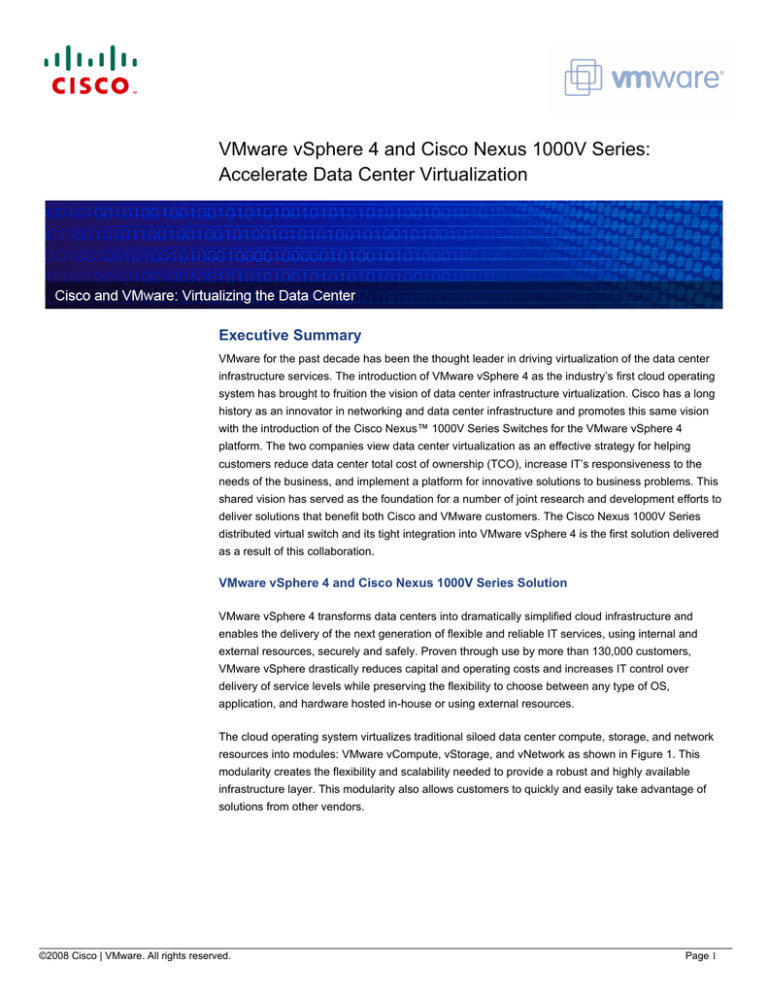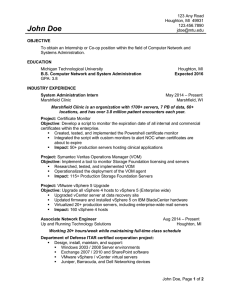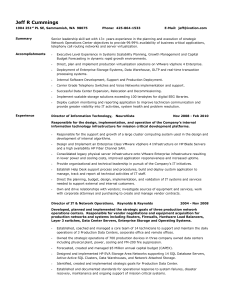VMware vSphere 4 and Cisco Nexus 1000V Series: Executive Summary
advertisement

VMware vSphere 4 and Cisco Nexus 1000V Series: Accelerate Data Center Virtualization Executive Summary VMware for the past decade has been the thought leader in driving virtualization of the data center infrastructure services. The introduction of VMware vSphere 4 as the industry’s first cloud operating system has brought to fruition the vision of data center infrastructure virtualization. Cisco has a long history as an innovator in networking and data center infrastructure and promotes this same vision with the introduction of the Cisco Nexus™ 1000V Series Switches for the VMware vSphere 4 platform. The two companies view data center virtualization as an effective strategy for helping customers reduce data center total cost of ownership (TCO), increase IT’s responsiveness to the needs of the business, and implement a platform for innovative solutions to business problems. This shared vision has served as the foundation for a number of joint research and development efforts to deliver solutions that benefit both Cisco and VMware customers. The Cisco Nexus 1000V Series distributed virtual switch and its tight integration into VMware vSphere 4 is the first solution delivered as a result of this collaboration. VMware vSphere 4 and Cisco Nexus 1000V Series Solution VMware vSphere 4 transforms data centers into dramatically simplified cloud infrastructure and enables the delivery of the next generation of flexible and reliable IT services, using internal and external resources, securely and safely. Proven through use by more than 130,000 customers, VMware vSphere drastically reduces capital and operating costs and increases IT control over delivery of service levels while preserving the flexibility to choose between any type of OS, application, and hardware hosted in-house or using external resources. The cloud operating system virtualizes traditional siloed data center compute, storage, and network resources into modules: VMware vCompute, vStorage, and vNetwork as shown in Figure 1. This modularity creates the flexibility and scalability needed to provide a robust and highly available infrastructure layer. This modularity also allows customers to quickly and easily take advantage of solutions from other vendors. ©2008 Cisco | VMware. All rights reserved. Page 1 Figure 1: vSphere 4: A realization of the Virtual Datacenter Operating System The VMware vNetwork module provides network infrastructure services to the cloud OS and delivers advanced features such as IPv6 support and third generation VMware VMXNET (VMXNET-3). A unique feature of the VMware vNetwork infrastructure module is that it isolates the network control plane from the network switching data plane, which improves management and enables the federation of the data plane across multiple disparate VMware vSphere servers. It also enables a new technology called the VMware vNetwork Distributed Switch (vDS), a federated network switching platform that spans several VMware vSphere servers. Introduced with VMware vSphere 4, the defining feature of VMware vDS is that the switching fabric resides virtually across multiple VMware vSphere servers, as shown in Figure 2. This feature enables virtual machines to migrate transparently from one VMware vSphere server to another. In addition, VMware vDS abstracts the configuration of individual virtual switches and provides a singlepane, centralized provisioning through its integration into VMware vCenter Server. VMware vNetwork module in that encompasses the vDS and VMXNET-3 enables inline monitoring and centralized firewall services and maintains the virtual machine's network run-time characteristics. Figure 2: VMware vSphere vNetwork distributed switch ©2008 Cisco | VMware. All rights reserved. Page 2 As part of its collaboration with VMware, Cisco has developed the first third-party vDS switch. The Cisco Nexus 1000V Series distributed switch replaces the VMware vDS in the VMware vNetwork layer, as shown in Figure 3. The Cisco Nexus 1000V Series is a full-fledged Cisco® NX-OS Software switch, which gives network administrators the same features, capabilities, and management functions that they have on traditional hardware-based switches, but now delivered with virtual machine–level granularity. Figure 3: VMware vSphere and Cisco Nexus 1000V series switch The benefit to the network administrator is that the Cisco Nexus 1000V Series Switch is managed like any other Cisco Nexus switch. Logically, the virtual switch behaves like a virtual modular switch. Network administers also have access to familiar tools such Encapsulated Remote Switched Port Analyzer (ERSPAN) and NetFlow. The result is operational consistency with the rest of the network, which translates to lower operating expenses and improved productivity. For server administrators, this enhanced network capability creates a more robust, more secure, and more responsive foundation to support virtual machines and their applications. Further, because access to the functions of the Cisco Nexus 1000V Series for server administrators is through VMware vCenter, administrators’ existing operation processes do not change. Business Benefits VMware vSphere coupled with the Cisco Nexus 1000V Series offers a number of short-long-term advantages to customers. In the short term, as customers begin to virtualize their data centers, the solution can help customers quickly scale their virtualization strategy by addressing some of the network, security, and operating challenges introduced by virtualization. In the longer term, as customers move toward cloud computing, VMware vSphere decouples applications and information from the complexity of underlying infrastructure, creating internal cloud infrastructure so that IT can focus on the support and enablement of business value. The Cisco Nexus 1000V Series, with its enhanced networking capabilities, makes the internal cloud infrastructure more robust and easier to manage. Benefits of VMware vSphere 4 and the Cisco Nexus 1000V Series switch include: ● Improved IT efficiency: VMware vSphere provides an efficient way of delivering IT services by optimizing both infrastructure investments and the resources consumed in managing and maintaining IT infrastructure. VMware vSphere delivers more than50 percent reduction in capital expenses and more than 60 percent reduction in operating expenses, achieving low TCO on a per-application basis. VMware vSphere delivers the highest consolidation ratios in the industry, with automated management and dynamic allocation of resources to applications across internal and external cloud infrastructures. The Cisco Nexus 1000V Series helps customers take advantage of the full potential of VMware vSphere by addressing many of the networking and security challenges and reducing the operational complexity that can slow the adoption of virtualization. The net result is a clean break from ©2008 Cisco | VMware. All rights reserved. Page 3 the expensive model of application and information delivery that is tied to specific systems and architectures, and transparent movement to a self-managed, dynamically optimized environment for efficient delivery of business services. ● Increased IT control through service-level automation: As businesses have become increasingly reliant on IT services, the effective delivery of applications can mean the difference between growth and decline, success and failure. Businesses depend on IT to fully control quality of service (QoS) for application delivery, without compromise. VMware vSphere 4 automates the delivery of service-level agreements (SLAs) covering availability, security, and scalability, shifting the model of data center management from infrastructure to service delivery. The interaction between VMware vCenter and the Cisco Nexus 1000V Series is an excellent example of the value of this level of automation. Changes to the network infrastructure are handled transparently and automatically, dramatically improving the efficiency, accuracy, and speed at which changes can be made to data center infrastructure. Application owners who need to roll out new business services are shielded from the complexities of server, storage, and network infrastructure, leaving them to focus on the delivery of business value. The result is an automated, controlled environment that is resilient to failures and responsive to changing requirements without complexity or operational overhead. ● Non-disruptive operations model: The VMware and Cisco solution allows customers to preserve their existing management model and operations best practices. Server and virtualization administrators continue to use VMware vCenter to manage their environments, and network administrators continue to use their existing network tools to manage the switches. Because VMware vCenter and the Cisco Nexus 1000V Series are so tightly coupled, the interactions between these teams are also simplified since moving a virtual machine no longer needs to involve any action on the part of the network team (such as VLAN reconfiguration). ● Increased security and compliance capabilities: The Cisco Nexus 1000V Series provides improved security and aides to maintain regulatory policies by providing capabilities to configure, maintain, and execute audits at the virtual machine–level granularity. In fact, the joint solution allows applications to be migrated to virtual machines that in the past could not be, because of security or compliance concerns. ● Choice and flexibility for IT departments: VMware vSphere future-proofs the IT department while delivering business services on demand, with the freedom to choose the right industry-standard hardware, application architecture, operating system, and in-house or external infrastructure for your changing business requirements. With VMware vSphere 4, customers retain flexibility of choice, remaining independent of hardware, operating system, application stack, and service providers. This means that customers can support their existing applications and feel confident about future applications while retaining the flexibility to deploy within internal or external cloud infrastructures. ©2008 Cisco | VMware. All rights reserved. Page 4 For more information, visit: www.vmware.com Cisco Systems, Inc. 170 West Tasman Drive San Jose, CA 95134-1706 USA www.cisco.com Tel: 408 526-4000 800 553-NETS (6387) Fax: 408 527-0883 VMware, Inc 3401 Hillview Ave Palo Alto, CA 94304 USA www.vmware.com Tel: 1-877-486-9273 or 650-427-5000 Fax: 650-427-5001 Copyright © 2008. VMware, Inc. All rights reserved. Protected by one or more U.S. Patent Nos. 6,397,242, 6,496,847, 6,704,925, 6,711,672, 6,725,289, 6,735,601, 6,785,886, 6,789,156, 6,795,966, 6,880,022, 6,944,699, 6,961,806, 6,961,941, 7,069,413, 7,082,598, 7,089,377, 7,111,086, 7,111,145, 7,117,481, 7,149, 843, 7,155,558, 7,222,221, 7,260,815, 7,260,820, 7,269,683, 7,275,136, 7,277,998,7,277,999, 7,278,030, 7,281,102, 7,290,253, 7,356,679 and patents pending. Cisco, the Cisco logo, and Cisco Systems are registered trademarks or trademarks of Cisco Systems, Inc. and/or its affiliates in the United States and certain other countries. All other trademarks mentioned in this document or Website are the property of their respective owners. The use of the word partner does not imply a partnership relationship between Cisco and any other company. (0807R) 09/08



